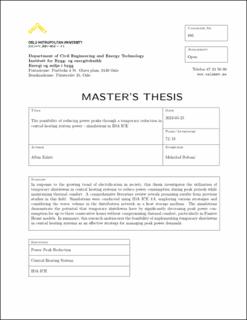| dc.description.abstract | In recent times there has been a trend of electrification worldwide, as large parts of the world move
away from the use of fossil fuels. This shift is of significant importance, particularly within the
building sector, which accounts for a significant portion of the electricity consumption. Furthermore,
this highlights the importance of implementing strategies to avoid power peaks, which put immense
strain on the electrical grid. Several different strategies have been proposed and analyzed by other
researchers thus far, with the intention of reducing and/or shifting such power peaks, in order to better
manage the available power without necessitating grid expansion solely for the accommodation of said
peaks.
This thesis examined the possibility of utilizing temporary shutdowns in available power in the central
heating system of an office building to reduce power consumption during these peaks, while simulta-
neously maintaining thermal comfort for the occupants. A literature review showed promising results
from earlier simulations and experiments, which had examined several aspects of the subject at hand,
including the thermal capacity of different constructions and dedicated thermal energy storage solu-
tions, as well as several different control strategies for different systems. In addition to the literature
review, multiple simulations employing different strategies were run in IDA ICE 4.8, for both a TEK17-
and Passive House-worthy building envelope. Furthermore, the total water volume of the distribution
pipes was considered as a heat storage medium. Custom controllers were developed using available
IDA ICE tools, in order to adjust the temperature setpoints and operation schedules of different
components, and their signals were logged to verify that they operated as expected.
The results indicate that there is a lot of potential in these temporary shutdowns with regard to
reduction of power consumption during periods of high demand. Among the most promising findings
was the fact that the heating power in the central heating system could be shut off completely for
up to three hours during a morning peak period without sacrificing thermal comfort. As expected,
the Passive House model showed better performance than the TEK17 model in all simulations. The
simulations also highlight the potential of considering the water volume in the distribution network as
short-term heat storage with regard to water-borne space heating systems. | en_US |
